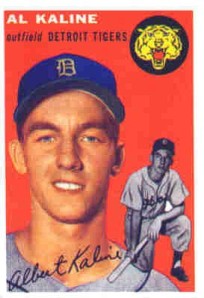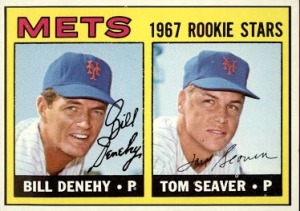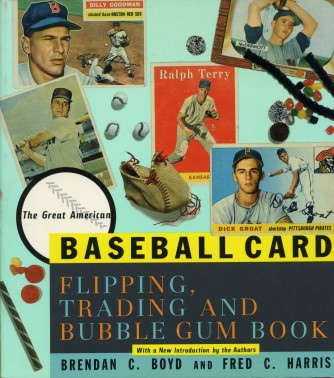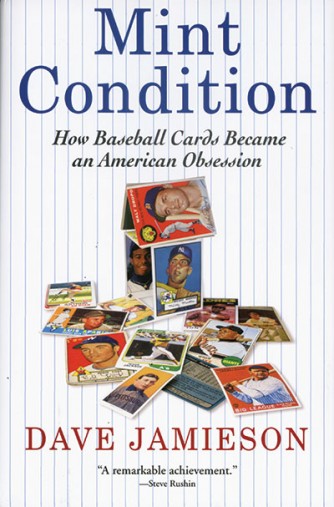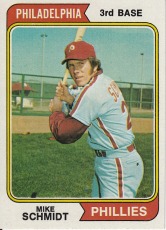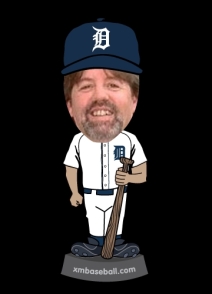When making Grail references, many these days go for the line from Indiana Jones & The Last Crusade (“You chose…….wisely”). Me? I’m an old fashioned traditionalist sort of guy who still prefers to pull my references from Monty Python. So, in response to Andy’s earlier article, I’m going to set myself up as his very own French Taunter.
“Your mother was a hamster, and your father smelt of elderberries!”
I’d like to share with you some of the cards that I’ve chased and found over the years, and the ones that I’d still love to add to my collection. I’ve been at this game a bit longer than Andy, having collected when I was a kid during the late 1960s/early 1970s before picking up the bug again about 1990. At that time, I concentrated on Detroit Tigers cards rather than set building. My early targets were fairly modest by today’s standards:
 1970 Topps #640 Al Kaline
1970 Topps #640 Al Kaline 1967 Topps #540 Norm Cash
1967 Topps #540 Norm Cash
1968 Topps #528 Tigers Team
1964 Topps #330 AL Bombers
Norm Cash and Al Kaline were two of my big heroes when I was growing up in Detroit. The 1970 Kaline card shows him in the classic 1960s Tigers grey road uniform – beautiful in its simplicity. The ’67 Cash was a toughie, coming as it did from the 1967 high series. The 1968 Tigers team card was a “must-have” featuring the World Series Champions of my youth. Lastly, how could I not want a card that showed not only Kaline and Cash, but also Yankees Home Run powerhouses Roger Maris and Mickey Mantle?
The cards above took a few years to collect, and by the time I added them my collecting habits had progressed to set building, cards featuring Scots born ballplayer Bobby Thomson, and sets from other sports. The next generation of Grail-shaped objects took on a different look:
1954 Topps #201 Al Kaline RC
1952 Topps #313 Bobby Thomson
1968 Topps #177 Nolan Ryan/Jerry Koosman RC
1967 Topps #581 Tom Seaver/Bill Denehy RC
After a few years, I started to get a bit more ambitious in my collecting aims. The card that immediately shot to the top of my wants list was the Kaline RC which I acquired as a gift from a fellow collector at the Atlanta National in 1999. The Ryan RC was a major stumbling block towards completing the 1968T set, but that also soon found its way into the binder. Among the standard Topps and Bowman issued Bobby Thomson cards, the 1952T is probably the toughest. It remains the ONLY 1952 high number card in my whole collection. Lastly, my quest to knock off the 1967 Topps set took a major leap forward when I acquired the Seaver RC in late 2012 from Kevin Savage Auctions. At $124, it is the most I’ve ever shelled out for a single card by quite some way.
So, which cards are at the pinnacle of my desires these days. Well, things sure don’t get any easier, but here we go:
1962 Ford Motor Co. Postcards Rocky Colavito
1963 Topps #537 Pete Rose RC
1965/66 Topps #122 Gordie Howe
1952 Coke Bobby Thomson
In 1962, the Ford Motor Co. produced a regionally issued set of postcards featuring Tigers players. Of the 17 cards in the set, a small handful are fairly common and show up regularly on auction sites. Most however are like hen’s teeth. Even finding images on the web can be tough! I’ve never seen the Colavito card, either in person or for sale online. No idea what sort of price it would demand, but I would think it’d be fairly steep.
The Rose RC is the only card I need to complete my 1963 Topps set. It’s incredibly tough to find a genuine one at a reasonable price. Not only has it been reprinted – legally but with no discerning reprint indications – its also been illegally counterfeited. Unless you get this from a dealer you can trust, you’re taking a hefty gamble! (Insert Pete Rose joke here).
The only non-baseball card in this article is the 1965/66 Gordie Howe short print. This card is virtually identical to his standard card within the set (#108), but is overprinted with the commemoration of Gordie’s 600th goal. A tough card, but one that I feel is definitely attainable.
Finally, I’d really like to add a 1952 Coke Bobby Thomson to my collection. This set featured players from the New York teams (the Yankees, Giants, and the Brooklyn Dodgers) and included home schedules and baseball tips. An example of the Thomson recently sold on eBay for $192. A gorgeous card.
So, there you have it. My “Holy Grail” cards past and present. Now go away before I taunt you a second time.
Glenn



